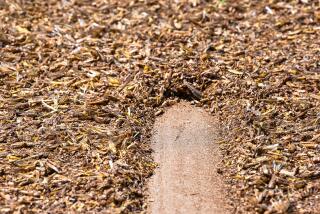For Growers, 1st Defense Should Be Beneficial Insect Habitats
- Share via
Strawberry and raspberry growers in Ventura County are experiencing economically damaging whitefly populations. Whiteflies suck the juice out of plants, stunting their production. Furthermore, they excrete honeydew, a sticky substance fed on by sooty mold, a fungus that makes berries unacceptable to buyers.
Normally, the whitefly is a minor pest in strawberry fields. So why now are large numbers of whiteflies appearing in the fields?
Perhaps the answer lies in the past. In the 1950s and ‘60s, researchers from the University of California’s now-defunct Department of Biological Control observed a whitefly explosion in California’s low desert cotton. The whiteflies had become resistant to all registered pesticides, including DDT. Whiteflies that survived pesticide applications simply kept reproducing. Researchers realized then that the basic law of nature--survival of the fittest--occurs not only in completely natural settings but in man-made agricultural ones as well. Whiteflies were a man-made pest because of the way growers were using pesticides.
Pesticide resistance is still a problem for controlling whiteflies as seen in the strawberry fields. Luckily, most growers know that pesticides are not the only line of defense. In natural wild lands, devastating pest outbreaks are usually kept under check by a plethora of predators, parasites, competitors, diseases and antagonists. These natural controls are also responsible for most pest control in modern agriculture.
However, pesticides can kill these organisms and create new pest outbreaks. Growers must preserve natural pest control and encourage more beneficial organisms at critical times during crop development. One way to create a natural balance of beneficial insects is by providing habitat for them.
From 1960 to ’65 in the Imperial Valley cotton fields, several researchers began studying beneficial insect habitats. They developed the theory that a complex of insects found in bordering alfalfa strips could control several key pests of cotton, including whiteflies.
The alfalfa “habitats” for beneficial insects led to a five-year period during which cotton was not sprayed in most of the valley. The economic value of biodiversity in agriculture was demonstrated. However, when the pink boll worm appeared in the area without its key parasites, around 1965, pesticides were chosen again as the method of choice for pest control.
Habitats for beneficial insects have been researched and demonstrated over and over since the 1960s. No longer are alfalfa strips the only demonstrated effective ones. Several seed companies have teamed up with researchers to offer farmers and gardeners seed blends that produce plant mixes that attract a complex of natural enemies. Effective habitats usually occupy 1% to 6% of the total farm area. However, they must be irrigated, planted and monitored by trained pest-control advisors.
These habitats also do not represent an overnight solution to the current whitefly explosion. However, if time and money were allocated now for planting habitats in strawberry fields, crops could be protected biologically next year and pesticide use could be reduced.
Why keep choosing the same tools to handle pest outbreaks when they no longer work? Growers should incorporate biological control into their overall pest management plans. They can obtain information, research papers and help from several California-based organizations. Whenever a pest outbreak occurs, the first reaction should not be to reach for a new spray bottle. The first reaction should be to reach for the seeds that will grow a farm’s natural enemy complex.
Perhaps a tax on environmentally unfriendly pesticides would decrease their use and this money could fund the transition to ecologically based pest management.
Several organizations can help growers obtain information about alternatives to pesticides. Your local UC Cooperative Extension is great place to learn more, as is a community garden. The Dietrick Institute for Applied Insect Ecology in Ventura can also put you in contact with local researchers and growers who are developing ecologically based pest-management strategies. Write to them at P.O. Box 2506, Ventura, CA 93002.






